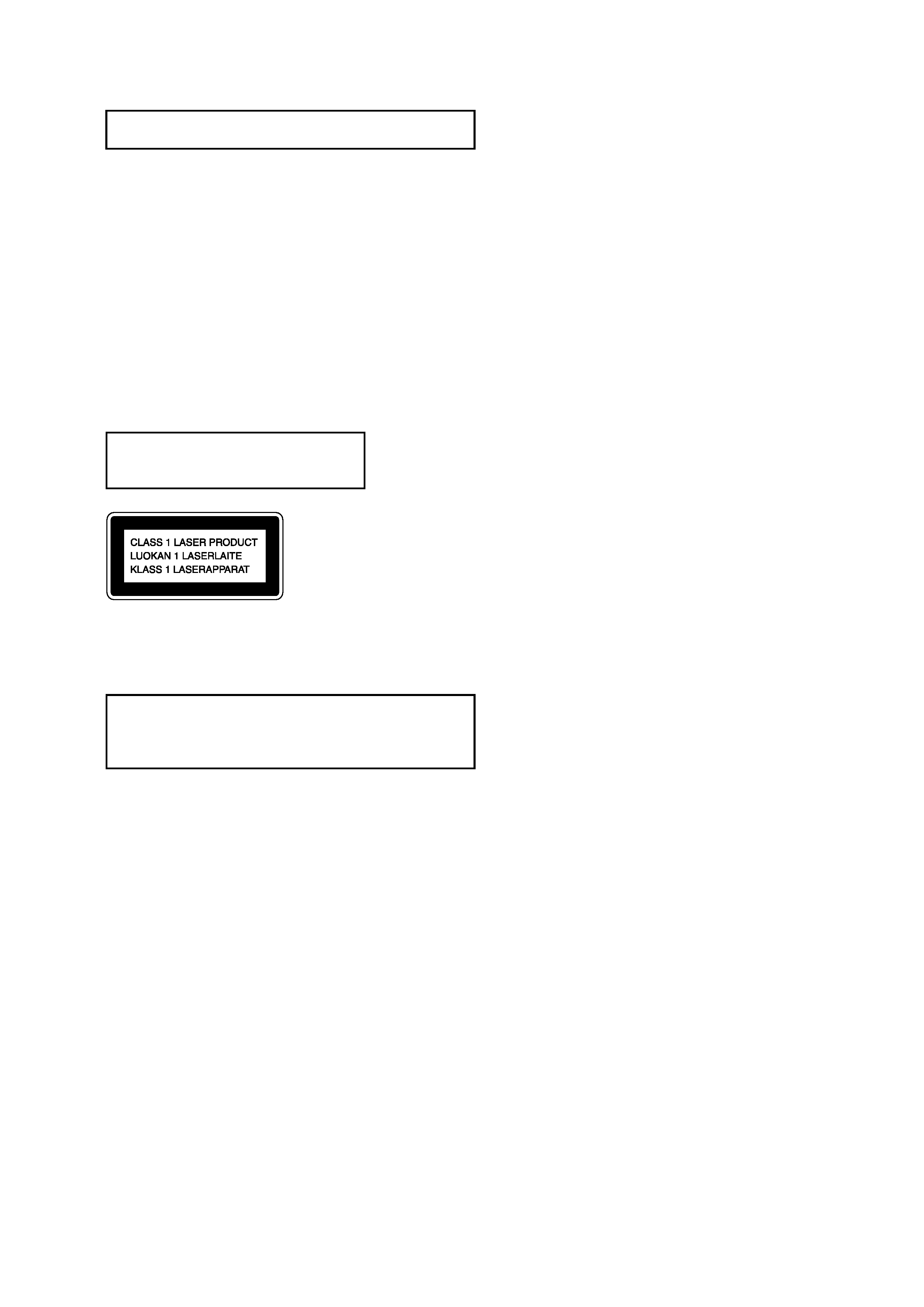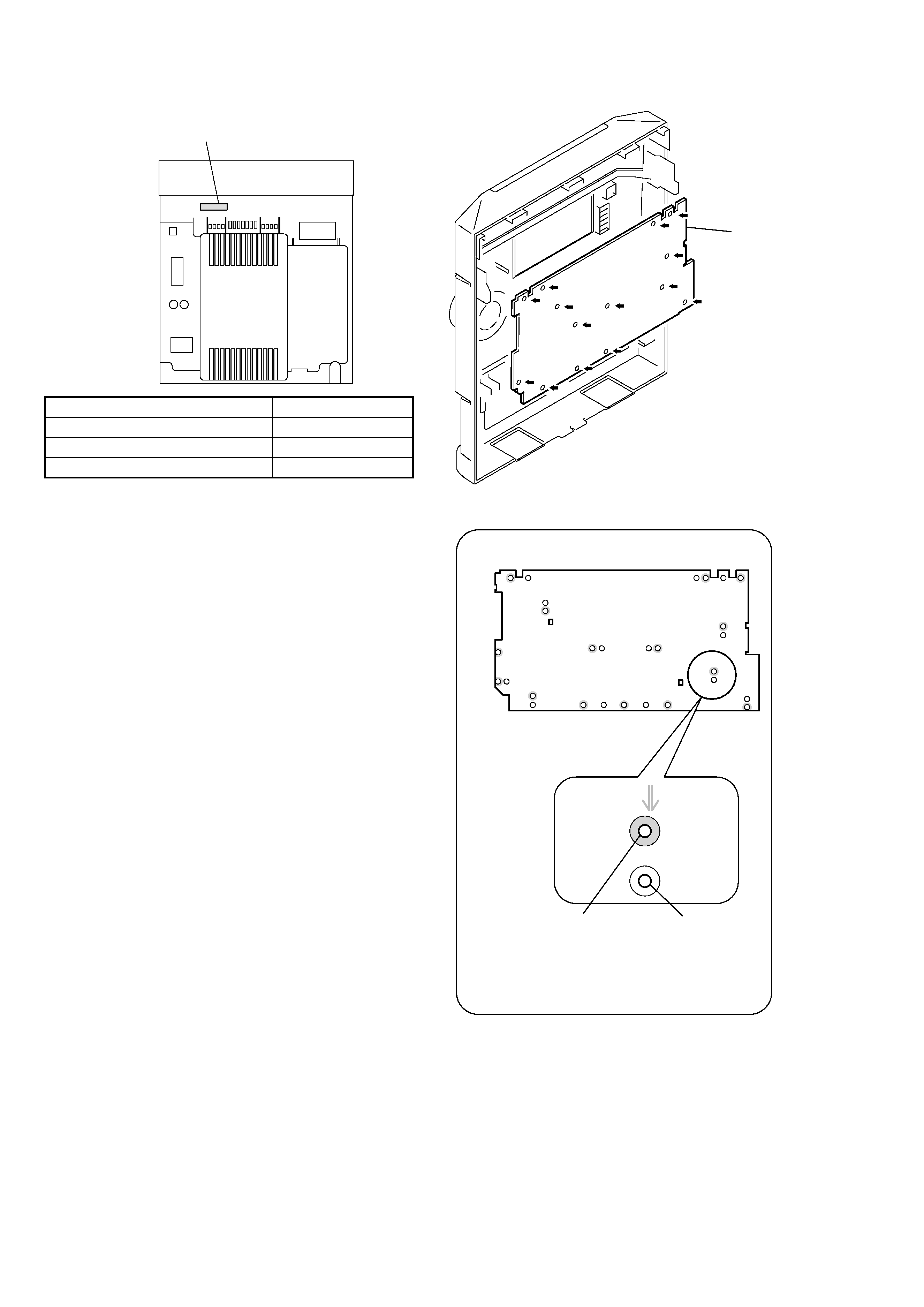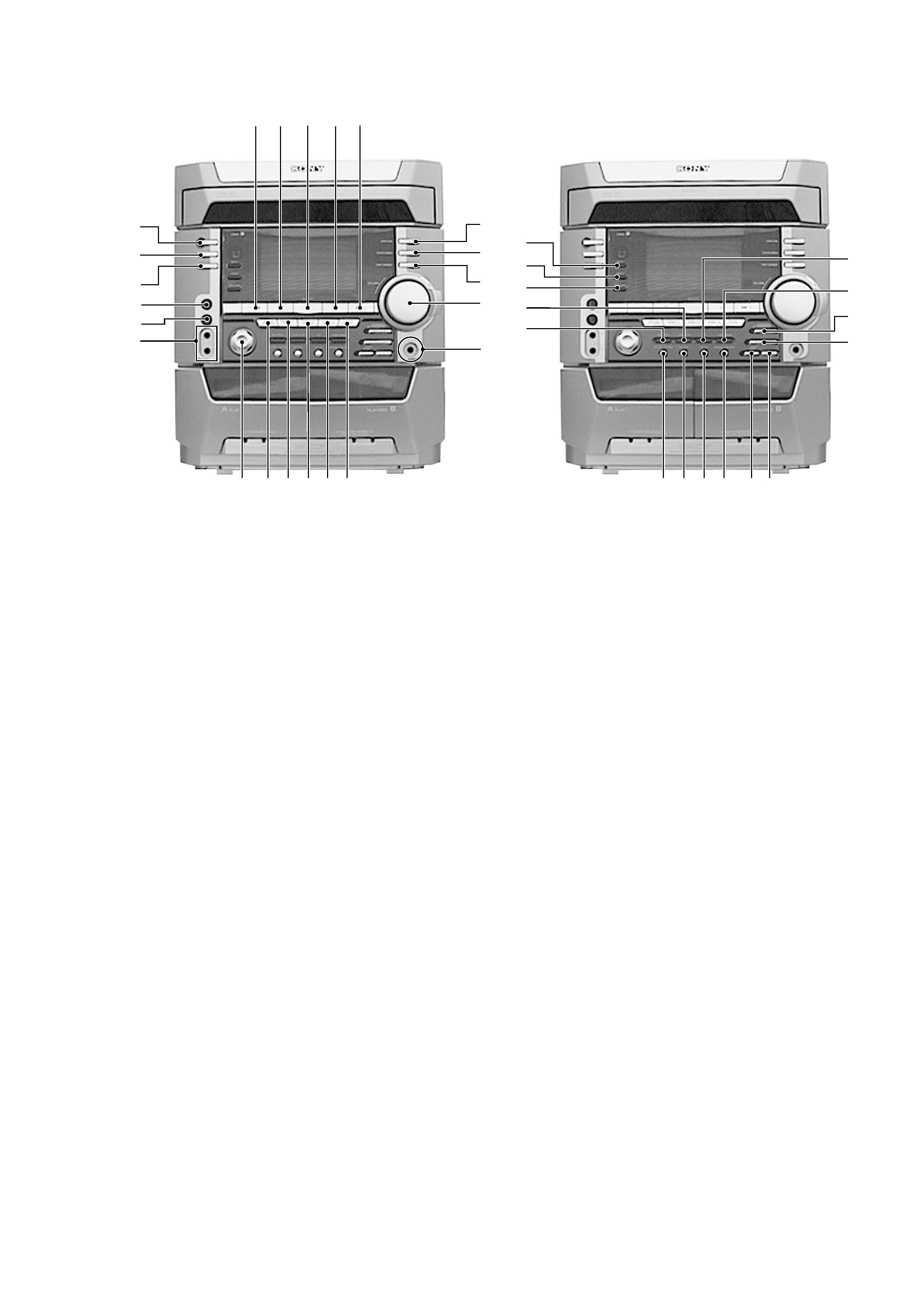
HCD-VX33
E Model
Tourist Model
SERVICE MANUAL
MINI Hi-Fi COMPONENT SYSTEM
-- Continued on next page --
SPECIFICATIONS
· HCD-VX33 is the tuner, deck, CD
and amplifier section in MHC-
VX33.
Model Name Using Similar Mechanism
NEW
CD
CD Mechanism Type
CDM58-K2BD37A
Section
Base Unit Name
BU-K2BD37A
Optical Pick-up Name
KSM-213DAP
Tape deck
Model Name Using Similar Mechanism
NEW
Section
Tape Transport Mechanism Type
TCM-230AWR11
Amplifier section
MHC-VX33:
The following measured at AC 120, 220, 240 V
50/60 Hz
DIN power output (rated) 75 + 75 watts
(6 ohms at 1 kHz, DIN)
Continuous RMS power output (reference)
100 + 100 watts
(6 ohms at 1 kHz,
10% THD)
Inputs
MD/VIDEO IN:
voltage 450/250 mV,
(phono jacks)
impedance 47 kilohms
MIC:
sensitivity 1 mV,
(mini jack)
impedance 10 kilohms
Outputs
VIDEO OUT:
max. output level
(phono jack)
1Vp-p, unbalanced, Sync
negative, load impedance
75 ohms
S-VIDEO OUT:
Y: 1Vp-p, unbalanced,
(4-pin/mini-DIN jack)
Sync negative,
C: 0.286Vp-p,
load impedance 75 ohms
PHONES:
accepts headphones of
(stereo mini jack)
8 ohms or more
SPEAKER:
MHC-VX33:
accepts impedance of 6 to
16 ohms
VIDEO CD/CD player section
System
Compact disc and digital
audio system
Laser
Semiconductor laser
(
=780 nm)
Emission duration:
continuous
Laser output
Max. 44.6
µW*
*This output is the value
measured at a distance of
200 mm from the
objective lens surface on
the Optical Pick-up Block
with 7 mm aperture.
Wavelength
780 -- 790 nm
Frequency response
2 Hz -- 20 kHz (
±0.5 dB)
Signal-to-noise ratio
More than 90 dB
Dynamic range
More than 90 dB
Video color system format
NTSC, PAL
CD OPTICAL DIGITAL OUT
(Square optical connector jack, rear panel)
Wavelength
660 nm
Output Level
--18 dBm

2
SAFETY-RELATED COMPONENT WARNING!!
COMPONENTS IDENTIFIED BY MARK 0 OR DOTTED LINE WITH
MARK 0 ON THE SCHEMATIC DIAGRAMS AND IN THE PARTS
LIST ARE CRITICAL TO SAFE OPERATION. REPLACE THESE
COMPONENTS WITH SONY PARTS WHOSE PART NUMBERS
APPEAR AS SHOWN IN THIS MANUAL OR IN SUPPLEMENTS
PUBLISHED BY SONY.
1.
Check the area of your repair for unsoldered or poorly-soldered
connections. Check the entire board surface for solder splashes
and bridges.
2.
Check the interboard wiring to ensure that no wires are
"pinched" or contact high-wattage resistors.
3.
Look for unauthorized replacement parts, particularly
transistors, that were installed during a previous repair. Point
them out to the customer and recommend their replacement.
4.
Look for parts which, through functioning, show obvious signs
of deterioration. Point them out to the customer and
recommend their replacement.
SAFETY CHECK-OUT
After correcting the original service problem, perform the following safety
checks before releasing the set to the customer.
5.
Check the B+ voltage to see it is at the values specified.
6.
Flexible Circuit Board Repairing
· Keep the temperature of the soldering iron around 270°C
during repairing.
· Do not touch the soldering iron on the same conductor of the
circuit board (within 3 times).
· Be careful not to apply force on the conductor when soldering
or unsoldering.
General
Power requirements
Thai model:
220 V AC, 50/60 Hz
Other models:
120 V, 220 V or
230 -- 240 V AC, 50/60 Hz
Adjustable with voltage
selector
Power consumption
190 watts
Dimensions (w/h/d)
Approx. 280 x 325 x 403 mm
Mass
Approx. 8.9 kg
Supplied accessories:
AM loop antenna (1)
FM lead antenna (1)
Remote Commander (1)
Batteries (2)
Video cable (1)
Front speaker pads (8)
Design and specifications are subject to change
without notice.
Tape player section
Recording system
4-track 2-channel stereo
Frequency response
40 -- 13,000 Hz (
±3 dB),
using Sony TYPE I
cassette
Tuner section
FM stereo, FM/AM superheterodyne tuner
FM tuner section
Tuning range
Tourist model:
76.0 -- 108.0 MHz
Other models:
87.5 -- 108.0 MHz
Antenna
FM lead antenna
Antenna terminals
75 ohm unbalanced
Intermediate frequency
10.7 MHz
AM tuner section
Tuning range
Middle Eastern model:
531 -- 1,602 kHz
(with the interval set at
9 kHz)
Other models:
531 -- 1,602 kHz
(with the interval set at
9 kHz)
530 -- 1,710 kHz
(with the interval set at
10 kHz)
Antenna
AM loop antenna
Antenna terminals
External antenna terminal
Intermediate frequency
450 kHz

3
This appliance is classified as a CLASS 1 LASER product. The
CLASS 1 LASER PRODUCT MARKING is located on the rear
exterior.
Laser component in this product is capable
of emitting radiation exceeding the limit for
Class 1.
CAUTION
Use of controls or adjustments or performance of procedures
other than those specified herein may result in hazardous radiation
exposure.
Notes on chip component replacement
· Never reuse a disconnected chip component.
· Notice that the minus side of a tantalum capacitor may be
damaged by heat.
Flexible Circuit Board Repairing
· Keep the temperature of soldering iron around 270°C
during repairing.
· Do not touch the soldering iron on the same conductor of the
circuit board (within 3 times).
· Be careful not to apply force on the conductor when soldering
or unsoldering.
NOTES ON HANDLING THE OPTICAL PICK-UP
BLOCK OR BASE UNIT
The laser diode in the optical pick-up block may suffer electrostatic
break-down because of the potential difference generated by the
charged electrostatic load, etc. on clothing and the human body.
During repair, pay attention to electrostatic break-down and also
use the procedure in the printed matter which is included in the
repair parts.
The flexible board is easily damaged and should be handled with
care.
NOTES ON LASER DIODE EMISSION CHECK
The laser beam on this model is concentrated so as to be focused on
the disc reflective surface by the objective lens in the optical pick-
up block. Therefore, when checking the laser diode emission,
observe from more than 30 cm away from the objective lens.
TABLE OF CONTENTS
1. SERVICE NOTE ······························································· 4
2. GENERAL ·········································································· 5
3. DISASSEMBY ·································································· 7
4. TEST MODE ···································································· 12
5. MECHANICAL ADJUSTMENTS ····························· 16
6. ELECTRICAL ADJUSTMENTS ······························· 16
7. DIAGRAMS
7-1. Circuit Board Location ················································· 23
7-2. Block Diagrams ···························································· 25
7-3. Printed Wiring Board
BD Section ····························· 28
7-4. Schematic Diagram
BD Section ································ 29
7-5. Printed Wiring Board
Main Section ·························· 30
7-6. Schematic Diagram
Main Section (1/3) ···················· 31
7-7. Schematic Diagram
Main Section (2/3) ···················· 32
7-8. Schematic Diagram
Main Section (3/3) ···················· 33
7-9. Printed Wiring Board
Power AMP Section ··············· 34
7-10. Schematic Diagram
Power AMP Section ················ 35
7-11. Printed Wiring Board
Panel Section ························ 36
7-12. Schematic Diagram
Panel Section ··························· 37
7-13. Printed Wiring Board
Leaf SW Section ··················· 38
7-14. Schematic Diagram
Leaf SW Section ····················· 39
7-15. Printed Wiring Board
Driver Section ······················· 40
7-16. Schematic Diagram
Driver Section ························· 41
7-17. Printed Wiring Board
Video CD Section ················· 42
7-18. Schematic Diagram
Video CD Section (1/2) ··········· 43
7-19. Schematic Diagram
Video CD Section (2/2) ··········· 44
7-20. Printed Wiring Board
Power Section ······················· 45
7-21. Schematic Diagram
Power Section ·························· 45
7-22. IC Pin Function Description ······································· 46
7-23. IC Block Diagrams ····················································· 50
8. EXPLODED VIEWS
8-1. Main Section ································································· 54
8-2. Panel Section ································································ 55
8-3. Main Board Section ······················································ 56
8-4. Tape Mechanism Section (TCM-230PWR11) (1/2) ····· 57
8-5. Tape Mechanism Section (TCM-230PWR11) (2/2) ····· 58
8-6. CD Mechanism Section (CDM58-K2BD37) ··············· 59
9. ELECTRICAL PARTS LIST ······································· 60

4
SECTION 1
SERVICE NOTE
MODEL IDENTIFICATION
-- BACK PANEL --
MODEL
E, EA, HK, MY, SP, TW, JE models
TH model
IA model
PARTS No.
4-224-547-3s
4-224-547-5s
4-226-245-4s
PARTS No.
· Abbreviation
EA
:Saudi Arabia model
MY
:Malaysia model
SP
:Singapore model
TH
:Thai model
TW
:Taiwan model
IA
:Indonesia model
HK
:Hong Kong model
JE
:Tourist model
Screw hole
Attach the panel board with
fourteen screws (+BVTP 2.6
× 8 )
after the board is removed once.
Do not tighten the screws excessively.
1
Cut the fourteen melted-connection points with a cutting plier.
Note for installing the panel board
2
Panel board
Hot melt

5
SECTION 2
GENERAL
12 3
4 5
6
7
8
9
q;
qa
qs
qd
qf
qg
qh
qj
ql
qk
w;
wa
ws
wd
wf
wk
wl
e;
ea
es
ed
ef
eg
eh
ej
wg
wh
wj
1
. button
2
x button
3
gG/SELECT button
4
S button
5
> + button
6
PLAY MODE button
7
REPEAT button
8
EDIT button
9
VOLUME knob
q;
PHONE jack
qa
OPEN/CLOSE button
qs
DISC 3 button
qd
DISC 2 button
qf
DISC 1 button
qg
DISC SKIP EX-CHANGE button
qh
CURSOL button
qj
MIC jack
qk
ECHO LEVEL knob
ql
MIC LEVEL knob
w;
SPECTRUM button
wa
DISPLAY button
ws
@/1 button
wd
MD/VIDEO button and indicator
wf
TAPE A/B button and indicator
wg
RETURN button
wh
PREV button
wj
NEXT button
wk
CD button and indicator
wl
TUNER/BAND button and indicator
e;
GROOVE button and indicator
ea
CINEMA SPACE button and indicator
es
CD SYNC HI-DUB button
ed
REC PAUSE/START button and indicator
ef
KARAOKE PON/MPX button
eg
ENTER button
eh
EQ EDIT button
ej
PICTURE EFFECT button
